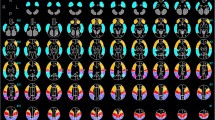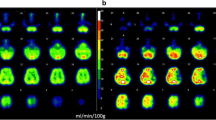Abstract
Objective
The present prospective study aimed to determine whether the addition of 123I-iomazenil (IMZ) single-photon emission computed tomography (SPECT) to brain perfusion SPECT could improve the detection accuracy of misery perfusion on positron emission tomography (PET) in adult patients with ischemic moyamoya disease (MMD).
Methods
Oxygen extraction fraction (OEF) and brain perfusion were assessed using 15O gas PET and N-isopropyl-p-[123I]-iodoamphetamine (IMP) SPECT, respectively, in 137 patients. IMZ SPECT was also performed. Regions of interest (ROIs) were automatically placed in the five middle cerebral artery (MCA) territories ipsilateral to the symptomatic cerebral hemisphere and in the contralateral posterior cerebral artery territory using a three-dimensional stereotaxic ROI template. The radioactive count of the MCA ROI to the contralateral posterior cerebral artery ROI was calculated on IMP SPECT (relative SPECT-IMP uptake) and IMZ SPECT (relative SPECT-IMZ uptake). The relative SPECT-IMZ uptake to the relative SPECT-IMP uptake was also calculated (relative SPECT-IMZ/IMP uptake). Of the five MCA ROIs in the symptomatic cerebral hemisphere in each patient, the ROI with the highest PET-OEF value (one ROI per patient) was selected for analysis.
Results
Significant correlations were observed between the PET-OEF and relative SPECT-IMP uptake (correlation coefficient, – 0.683) and relative SPECT-IMZ/IMP uptake (correlation coefficient, 0.875). The area under the receiver operating characteristic curve for detecting misery perfusion (PET-OEF > 51.3%) was significantly greater for the relative SPECT-IMZ/IMP uptake than for the relative SPECT-IMP uptake (difference between areas, 0.080; p = 0.0004). The sensitivity, specificity, and positive- and negative-predictive values for the relative SPECT-IMZ/IMP uptake for detecting misery perfusion were 100%, 92%, 81%, and 100%, respectively. The specificity and positive-predictive value were significantly greater for the relative SPECT-IMZ/IMP uptake than for the relative SPECT-IMP uptake.
Conclusions
The addition of IMZ SPECT to brain perfusion SPECT improves the detection accuracy of misery perfusion on PET in adult patients with ischemic MMD.






Similar content being viewed by others
Data Availability
All data generated or analyzed during this study are not publicly available on ethical grounds. However, inquiries regarding these data can be directed to the corresponding author.
Abbreviations
- AUC:
-
Area under the receiver operating characteristic curve
- CBF:
-
Cerebral blood flow
- CMRO2 :
-
Cerebral metabolic rate of oxygen
- CI:
-
Confidence interval
- ICA:
-
Internal carotid artery
- 123I-IMP:
-
N-Isopropyl-p-[123I]-iodoamphetamine
- IMZ:
-
123I-iomazenil
- MCA:
-
Middle cerebral artery
- MMD:
-
Moyamoya disease
- MRI:
-
Magnetic resonance imaging
- OEF:
-
Oxygen extraction fraction
- PET:
-
Positron emission tomography
- ROC:
-
Receiver operating characteristic
- ROI:
-
Region of interest
- SD:
-
Standard deviation
- SPECT:
-
Single-photon emission computed tomography
References
Fukui M. Research committee on the pathology and treatment of spontaneous occlusion of the circle of willis; health labour sciences research grant for research on measures for intractable diseases. Guidelines for diagnosis and treatment of moyamoya disease (Spontaneous occlusion of the circle of Willis). Neurol Med Chir (Tokyo). 2012;52:245–66.
Suzuki J, Takaku A. Cerebrovascular, “moyamoya” disease: Disease showing abnormal net-like vessels in base of brain. Arch Neurol. 1969;20:288–99.
Yanagihara W, Chida K, Kobayashi M, Kubo Y, Yoshida K, Terasaki K, et al. Impact of cerebral blood flow changes due to arterial bypass surgery on cognitive function in adult patients with symptomatic ischemic moyamoya disease. J Neurosurg. 2018;131:1716–24.
Uchida S, Kubo Y, Oomori D, Yabuki M, Kitakami K, Fujiwara S, et al. Long-term cognitive changes after revascularization surgery in adult patients with ischemic moyamoya disease. Cerebrovasc Dis Extra. 2021;11:145–54.
Kimura K, Kubo Y, Dobashi K, Katakura Y, Chida K, Kobayashi M, et al. Angiographic, cerebral hemodynamic, and cognitive outcomes of indirect revascularization surgery alone for adult patients with misery perfusion due to ischemic moyamoya disease. Neurosurgery. 2022;90:676–83.
Ogasawara K, Uchida S, Akamatsu Y, Chida K, Kobayashi M, Yoshida K, et al. Outcomes of medical management alone for adult patients with cerebral misery perfusion due to ischemic moyamoya disease. J Stroke Cerebrovasc Dis. 2022;31: 106588.
Miyoshi K, Chida K, Kobayashi M, Kubo Y, Yoshida K, Terasaki K, et al. Two-year clinical, cerebral hemodynamic, and cognitive outcomes of adult patients undergoing medication alone for symptomatically ischemic moyamoya disease without cerebral misery perfusion: a prospective cohort study. Neurosurgery. 2019;84:1233–41.
Kitakami K, Kubo Y, Yabuki M, Oomori D, Takahashi T, Igarashi S, et al. Five-year outcomes of medical management alone for adult patients with ischemic moyamoya disease without cerebral misery perfusion. Cerebrovasc Dis 51:158–64.
Baron JC, Bousser MG, Rey A, Guillard A, Comar D, Castaigne P. Reversal of focal “misery-perfusion syndrome” by extra-intracranial arterial bypass in hemodynamic cerebral ischemia: a case study with 15O positron emission tomography. Stroke. 1981;12:454–9.
Nemoto EM, Yonas H, Kuwabara H, Pindzola RR, Sashin D, Meltzer CC, et al. Identification of hemodynamic compromise by cerebrovascular reserve and oxygen extraction fraction in occlusive vascular disease. J Cereb Blood Flow Metab. 2004;24:1081–9.
Yamauchi H, Okazawa H, Kishibe Y, Sugimoto K, Takahashi M. Oxygen extraction fraction and acetazolamide reactivity in symptomatic carotid artery disease. J Neurol Neurosurg Psychiatry. 2004;75:33–7.
Setta K, Kojima D, Shimada Y, Yoshida J, Oshida S, Fujimoto K, et al. Accuracy of brain perfusion single-photon emission computed tomography for detecting misery perfusion in adult patients with symptomatic ischemic moyamoya disease. Ann Nucl Med. 2018;32:611–9.
Bremner JD, Baldwin R, Horti A, Staib LH, Ng CK, Tan PZ, et al. Quantitation of benzodiazepine receptor binding with PET [11C]iomazenil and SPECT [123I]iomazenil: preliminary results of a direct comparison in healthy human subjects. Psychiatry Res. 1999;91:79–91.
Woods SW, Seibyl JP, Goddard AW, Dey HM, Zoghbi SS, Germine M, et al. Dynamic SPECT imaging after injection of the benzodiazepine receptor ligand [123I]iomazenil in healthy human subjects. Psychiatry Res. 1992;45:67–77.
Busatto GF, Pilowsky LS, Costa DC, Ell PJ, Lingford-Hughes A, Kerwin RW. In vivo imaging of GABAA receptors using sequential whole-volume iodine-123 iomazenil single-photon emission tomography. Eur J Nucl Med. 1995;22:12–6.
Dong Y, Fukuyama H, Nabatame H, Yamauchi H, Shibasaki H, Yonekura Y. Assessment of benzodiazepine receptors using iodine-123-labeled iomazenil single-photon emission computed tomography in patients with ischemic cerebrovascular disease: a comparison with PET study. Stroke. 1997;28:1776–82.
Chida K, Ogasawara K, Kuroda H, Aso K, Kobayashi M, Fujiwara S, et al. Central benzodiazepine receptor binding potential and cerebral blood flow images on SPECT correlate with oxygen extraction fraction images on PET in cerebral cortex with unilateral major cerebral artery occlusive disease. J Nucl Med. 2011;52:511–8.
Ibaraki M, Miura S, Shimosegawa E, Sugawara S, Mizuta T, Ishikawa A, et al. Quantification of cerebral blood flow and oxygen metabolism with 3-dimensional PET and 15O: validation by comparison with 2-dimensional PET. J Nucl Med. 2008;49:50–9.
Frackowiak RS, Lenzi GL, Jones T, Heather JD. Quantitative measurement of regional cerebral blood flow and oxygen metabolism in man using 15O and positron emission tomography: theory, procedure, and normal values. J Comput Assist Tomogr. 1980;4:727–36.
Nishimiya M, Matsuda H, Imabayashi E, Kuji I, Sato N. Comparison of SPM and NEUROSTAT in voxelwise statistical analysis of brain SPECT and MRI at the early stage of Alzheimer’s disease. Ann Nucl Med. 2008;22:921–7.
Takeuchi R, Matsuda H, Yoshioka K, Yonekura Y. Cerebral blood flow SPET in transient global amnesia with automated ROI analysis by 3DSRT. Eur J Nucl Med Mol Imaging. 2004;31:578–89.
Hishikawa T, Tokunaga K, Sugiu K, Date I. Assessment of the difference in posterior circulation involvement between pediatric and adult patients with moyamoya disease. J Neurosurg. 2013;119:961–5.
Narisawa A, Fujimura M, Tominaga T. Efcacy of the revascularization surgery for adult-onset moyamoya disease with the progression of cerebrovascular lesions. Clin Neurol Neurosurg. 2009;111:123–6.
Braestrup C, Albrechtsen R, Squires RF. High densities of benzodiazepine receptors in human cortical areas. Nature. 1977;269:702–4.
Funding
This work was partly supported by Grants-in-Aids from the Scientific Research KAKEN from the Japan Society for the Promotion of Science (21K09108 and 21K09157) and Grants-in-Aids from the National Hospital Organization Kamaishi Hospital KENKYUHI.
Author information
Authors and Affiliations
Corresponding author
Ethics declarations
Conflict of interest
The author (Kuniaki Ogasawara) declared the following potential conflict of interest with respect to the research, authorship, and/or publication of this article: Consigned research funds from Nihon Medi-Physics Co., Ltd.
Additional information
Publisher's Note
Springer Nature remains neutral with regard to jurisdictional claims in published maps and institutional affiliations.
Rights and permissions
Springer Nature or its licensor (e.g. a society or other partner) holds exclusive rights to this article under a publishing agreement with the author(s) or other rightsholder(s); author self-archiving of the accepted manuscript version of this article is solely governed by the terms of such publishing agreement and applicable law.
About this article
Cite this article
Ogasawara, K., Takahashi, T., Igarashi, S. et al. Effect of the addition of 123I-iomazenil single-photon emission computed tomography to brain perfusion single-photon emission computed tomography on the detection accuracy of misery perfusion in adult patients with ischemic moyamoya disease. Ann Nucl Med 37, 280–288 (2023). https://doi.org/10.1007/s12149-023-01825-0
Received:
Accepted:
Published:
Issue Date:
DOI: https://doi.org/10.1007/s12149-023-01825-0




